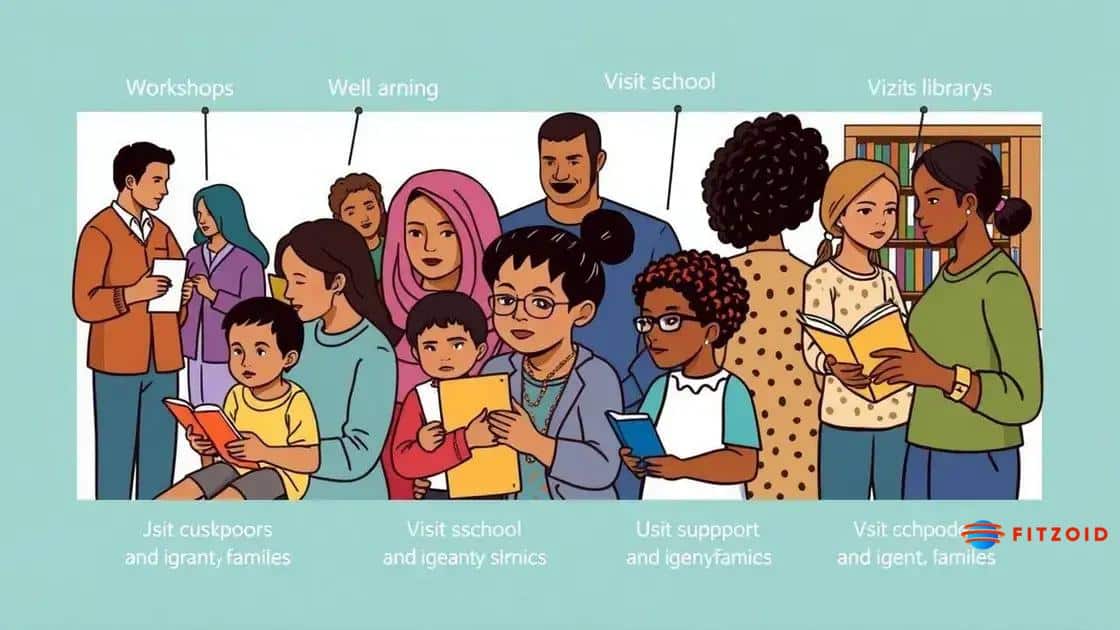Immigrant student education rights: what you need to know
Anúncios
Immigrant student education rights ensure that all students, regardless of immigration status, have access to public education, necessary support resources, and the ability to advocate for fair treatment within the school system.
Immigrant student education rights are critical for ensuring that every child receives a fair opportunity to excel in their education. Have you ever wondered what those rights entail and how they impact students personally? In this article, we’ll dive into the essentials that every immigrant student and family should know.
Understanding immigrant education rights
Understanding immigrant education rights is essential for both students and families. This knowledge can empower them to navigate the education system effectively. The rights of immigrant students are defined by federal and state laws aimed at providing equal educational opportunities.
Anúncios
What Are Immigrant Education Rights?
Immigrant education rights ensure that all students, regardless of their immigration status, can access public education. These rights are protected under various federal laws such as the Plyler v. Doe decision, which ruled that no child should be denied access to public education based on their immigration status.
Key Protections for Immigrant Students
Several key protections exist to safeguard the education of immigrant students. Some important points include:
Anúncios
- All children have the right to enroll in school without discrimination.
- Schools cannot inquire about a student’s immigration status.
- Immigrant students are entitled to the same quality of education as their peers.
Understanding these rights helps students feel secure in their learning environment. Immigrant education rights promote inclusivity and diversity in schools, which benefits all students.
Many immigrant students may face unique challenges such as language barriers and cultural adjustments. Schools often offer additional resources, such as ESL (English as a Second Language) programs, to support them. It’s crucial for families to be informed about these resources and to seek assistance if needed.
Resources to Support Immigrant Students
Various organizations and initiatives provide support for immigrant families. Consider looking into:
- Nonprofits offering legal assistance for education rights.
- Community centers that provide tutoring and language classes.
- School district programs designed to help acclimate immigrant students.
By understanding their education rights, immigrant families can advocate for themselves and ensure their children receive the education they deserve. It is important to stay informed and proactive regarding educational opportunities and resources available.
In summary, knowing about immigrant education rights is crucial for students and families navigating the education system. This knowledge empowers them and helps build a supportive learning environment.
laws protecting immigrant students

Key laws protecting immigrant students ensure they receive an equitable education, regardless of their immigration status. These laws form a foundation for educational rights and access in schools across the United States.
Plyler v. Doe
This landmark Supreme Court case from 1982 established that immigrant students cannot be denied access to public education based on their legal status. This ruling reflects the idea that education is a fundamental right for all children.
Every Student Succeeds Act (ESSA)
The ESSA, enacted in 2015, emphasizes the importance of providing equal educational opportunities for all students, including immigrant students. Under this law, schools must evaluate the needs of students and provide necessary supports to help them succeed academically.
Equal Educational Opportunities Act (EEOA)
The EEOA prohibits discrimination against any student based on their race, color, or national origin. This act plays a crucial role in protecting immigrant students from bias and ensuring that they receive a quality education. Schools are required to take proactive steps to eliminate barriers and promote inclusivity.
In addition to federal laws, many states have their own laws aimed at protecting immigrant education rights. These may include provisions for language assistance, anti-discrimination policies, and access to educational resources. Knowing these laws enables families to advocate effectively for their children.
Resources for Immigrant Families
Organizations often provide support to help families understand their rights. Here are some helpful resources:
- Local advocacy groups that specialize in immigrant education rights.
- Legal aid organizations that assist with education-related issues.
- Community programs that focus on educational equity for immigrant students.
Engaging with these resources helps families navigate the complexities of the education system and ensures that their rights are upheld. By understanding the key laws, immigrant students and their families can better advocate for their educational needs.
Common challenges faced by immigrant students
Common challenges faced by immigrant students can greatly affect their educational experience. Understanding these obstacles is important for both students and educators.
Language Barriers
Many immigrant students enter schools with limited English proficiency. This can make it difficult to engage with teachers and classmates. Language barriers may lead to misunderstandings in class and impact academic performance.
Cultural Adjustment
Adjusting to a new culture can be challenging. Immigrant students often face differences in social norms and expectations. This can lead to feelings of isolation or anxiety as they try to fit in with their peers.
Social Integration
Social integration is another significant hurdle. Immigrant students may struggle to form friendships due to language differences or cultural background. This lack of social connection can affect their overall well-being and academic success.
In addition to these challenges, educational disparities can arise. Some immigrant students come from countries where education systems differ greatly from those in the U.S. This may result in gaps in knowledge, making it difficult for them to keep up in their new classrooms.
Access to Resources
Access to educational resources is often limited for immigrant students. They may not be aware of available support services or extracurricular activities. Understanding what is offered at their schools can empower them to take advantage of these opportunities.
Families may also face difficulties in navigating the education system. Lack of familiarity with school policies or resources can create additional stress. Schools can help by providing information in multiple languages and engaging with parents.
Emotional and Mental Health Issues
Finally, emotional and mental health issues can pose significant challenges. The stress of adapting to a new environment and the pressure to succeed can lead to anxiety and depression among some immigrant students. Providing a supportive environment and counseling resources can help address these issues.
Resources and support for immigrant families

Resources and support for immigrant families are crucial for helping them navigate the education system. Accessing these resources can make a significant difference in their children’s academic success.
Community Organizations
Many community organizations provide valuable services specifically for immigrant families. These organizations often offer outreach programs, educational workshops, and legal assistance. They help families understand their rights and the resources available to them.
School Resources
Schools often have specific resources dedicated to support immigrant students. Language assistance programs, counseling services, and after-school tutoring are some examples. It is important for families to communicate with school personnel to find out what support is available.
Connecting with parent-teacher associations can also be beneficial. These associations often work to help integrate immigrant families into the school community and can provide valuable information regarding school activities and policies.
Government Programs
Various government programs aim to support immigrant families. Federal and state agencies may offer assistance, including free or reduced-cost meals, scholarships, and educational grants. Familiarity with these programs can help families take advantage of support that is available to them.
Libraries are another great resource. Many libraries provide free tutoring, language classes, and materials that support learning in multiple languages. Public libraries often host events to help immigrant families engage with the community and access further educational resources.
Online Resources
In today’s digital age, online resources can also be very helpful. Websites and platforms provide information about immigration laws, educational rights, and available services. These online tools can empower immigrant families to navigate their challenges effectively.
Being aware of these resources allows immigrant families to build a strong support network. Together, these resources can provide the necessary guidance and assistance for navigating the education system successfully.
Steps to advocate for your education rights
Steps to advocate for your education rights are essential for ensuring that every student receives fair treatment in schools. Knowing how to navigate this process can empower students and their families.
Understand Your Rights
The first step is to understand what your education rights are. Immigrant students have the same rights as all students in the U.S. This includes the right to enroll in school regardless of immigration status. Familiarizing yourself with these rights helps you advocate effectively.
Communicate with School Staff
Open communication with teachers and school administrators is key. If you have questions or concerns about your rights, reach out to school staff directly. Develop a relationship with your teachers and ask about any resources available to support you or your family.
- Email or meet with teachers to discuss concerns.
- Attend back-to-school nights and parent meetings.
- Join school committees to stay involved.
Creating these connections can help build a support network within the school.
Research Available Resources
Knowing what resources are available can greatly benefit immigrant families. Look for community organizations that offer assistance with educational advocacy. These organizations often provide workshops and counseling to help families understand their rights.
Additionally, schools may have resources such as language services and counseling. Utilizing these resources can enhance your educational experience.
Seek Legal Assistance if Necessary
If you believe your education rights are being violated, it may be necessary to seek legal assistance. Many nonprofit organizations specialize in immigrant education rights and can offer guidance. This may include legal representation or advice on how to address specific issues.
It’s vital to document any incidents that may indicate a violation of your rights. Keep a record of conversations and communications regarding your concerns.
Be Informed and Active
Finally, staying informed about local policies and changes in immigration law is crucial. Being an active participant in your education can help you advocate for yourself and others. Attend workshops, read updates from advocacy groups, and connect with fellow students or families facing similar challenges.
By taking these steps, students and families can work together to ensure that their education rights are recognized and upheld.
In summary, understanding and advocating for immigrant student education rights is vital for ensuring that all students have access to a quality education. By recognizing their rights, communicating with school staff, and utilizing available resources, students and families can empower themselves. Advocacy plays a crucial role in overcoming challenges and promoting fairness in education. Together, by staying informed and active, immigrant families can navigate the educational system effectively and ensure a brighter future for their children.
FAQ – Frequently Asked Questions about Immigrant Student Education Rights
What are my rights as an immigrant student?
As an immigrant student, you have the right to enroll in public school regardless of your immigration status and to receive a fair education.
How can I advocate for my education rights?
You can advocate for your education rights by understanding them, communicating with school staff, and utilizing available resources.
What resources are available for immigrant families?
Immigrant families can access community organizations, school resources, and legal aid to help navigate the education system.
What should I do if I face discrimination at school?
If you face discrimination, document the incidents and seek help from teachers, school counselors, or legal assistance if necessary.





